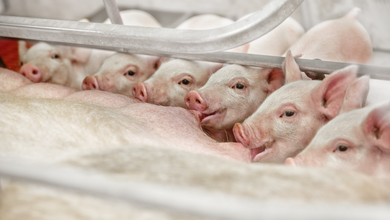
Published on Nov. 10, 2023
The Impact of Genetics on Sow Health and Welfare: Results from the Field
Discover how Hypor genetics make a real impact in the field when it comes to sow survivability. Customer data from our benchmark report shows that the sow death loss rate for all farms in the Americas Libra Benchmark has been 22% lower than the SMS benchmark (i.e., industry) average of 10.6% since 2017. The difference between benchmarks has now widened to 3.0 percentage points over the past two years.
Sow mortality continues to be a pressing issue affecting the sustainability of the swine industry. An increase in sow mortality has negative implications for economic results, animal welfare standards and staff morale. Not to mention the waste of resources, including feed, water, and energy, in raising and managing sows for production.
There are infectious and non-infectious causes of sow mortality. Infectious causes can be reduced through a high health status, via strict biosecurity protocols and proper individual animal care. Non-infectious causes are primarily lameness, prolapse, and factors leading to sudden death. Proper sow and herd management is critical to increase sow survivability rates and improve sow welfare, but genetics also plays an important role. By selecting for robustness via traits such as feet and leg structure along with beneficial social behavior, the result is a sociable and calm sow, well suited for all housing systems with reduced lameness and improved survivability.
We are pleased to see that results from the field demonstrate this focus on sow health. The top farms globally using Hypor Libra sows have an average sow survivability rate of >95% (death loss rate of <5%) over the past three years. Specific to farms in the Americas, the death loss rate in the Libra Americas Benchmark has been 22% lower than the SMS benchmark (i.e., industry) average of 10.6% since 2017. Results show that, most Libra herds had a sow death loss rate below 8% and only 4% of farms surpassed the 15% threshold (see figure). To give further context, just a 1 percentage point (pp) improvement in sow survivability can make an impressive difference in cost savings. Research from Iowa State University has found that a 1pp increase in sow survivability translates to savings of $11.40 USD/sow/year. This equates to $28,490/year on a 2500 head farm.

We are pleased to see that results from the field demonstrate this focus on sow health. The top farms globally using Hypor Libra sows have an average sow survivability rate of >95% (death loss rate of <5%) over the past three years. Specific to farms in the Americas, the death loss rate in the Libra Americas Benchmark has been 22% lower than the SMS benchmark (i.e., industry) average of 10.6% since 2017.
Results show that, most Libra herds had a sow death loss rate below 8% and only 4% of farms surpassed the 15% threshold (see figure). To give further context, just a 1 percentage point (pp) improvement in sow survivability can make an impressive difference in cost savings. Research from Iowa State University has found that a 1pp increase in sow survivability translates to savings of $11.40 USD/sow/year. This equates to $28,490/year on a 2500 head farm.
The Hypor approach has been to improve survivability for both the piglet and sow, through our 16-15-14 sustainability standard for litter characteristics: 16 total born, 15 born alive, and 14 weaned. With this commitment to sustainable improvement, we can create a more viable industry in all dimensions, including economic, social, and environmental.
Click to read the full technical article



